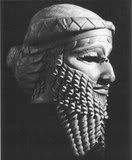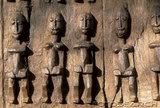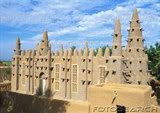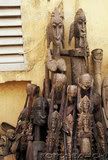Friday, June 1, 2007
African Roots of Humanity and Civilization - Part V - Australia and Oceanica
THE BLACK PRESENCE IN AUSTRALIA AND OCEANICA
The Black Presence in Australia: Fighting for Survival
Australia was settled at least 50,000 years ago by people who call themselves Blackfellas, and who are usually referred to as the Australian Aborigines. Physically, the Blackfellas are distinguished by straight to wavy hair textures, and dark to near black complexions. In January 1788, when Britain began using Australia as a prison colony, an estimated 300,000 indigenous people were spread across the continent in about six-hundred small-scale societies. Each of these communities maintained social, religious, and trade connections with its neighbors.
The dumping of British convicts into Australia proved catastrophic for the Blacks. Victims of deliberate poisonings, calculated and systematic slaughters; decimated by tuberculosis and syphilis; swept away by infectious epidemics; their community structures and moral fibers shredded, by the 1930's the Blackfellas had been reduced to a pathetic remnant of about 30,000 people, and perhaps twice that number of mixed descent.
When the continent was invaded by Europeans in the nineteenth century, the white historians who wrote about Australia invariably included a section on the Blacks, and acknowledged that the original inhabitants of the continent had had an historical role. After 1850, however, few writers referred to the Blacks at all. The Black were thought of as a "dying race." By 1950 general histories of the continent by European-Australians almost never referenced the indigenous people. During this period--the indigenous people--whether part or full blood, were excluded from all major European-Australian institutions, including schools, hospitals and labor unions. They could not vote. Their movements were restricted. They were outcasts in white Australia.
Today, the Blacks of Australia are terribly oppressed, and they remain in a desperate struggle for survival. Recent demographic surveys, for example, show that the Black infant mortality rate is the highest in Australia. Aborigines have the shoddiest housing and the poorest schools. Their life expectancy is twenty years less than Europeans. Their unemployment rate is six times higher than the national average. Aborigines did not obtain the right to vote in federal elections until 1961, nor the right to consume alcoholic beverages until 1964. They were not officially counted as Australian citizens until after a constitutional amendment in 1967. Today, the indigenous people constitute less than two per cent of the total Australian population.
Perhaps the Blackfellas should consider themselves fortunate. The Black aborigines of Tasamania were completely destroyed. Tasmania, an island only slightly larger than West Virginia, lies two-hundred miles off Australia's southeast coast. In 1802, following mainland Australia, Tasmania was established as a British prison colony. The colonial government itself was not even inclined to consider the Tasmanians as full human beings. To the Europeans of the island, the Tasmanians were a people fit only to be exploited in the cruelest of manners. European convicts regularly hunted Tasmanians for sport, casually shooting, spearing or clubbing the men to death, torturing and raping the women. Europeans murdered Tasmanians for use as dog food. Tasmanian infants were burned alive. Tasmanian women were kidnapped and chained, and exploited as sexual slaves. Between 1802 and 1830 the Tasmanians were reduced from an estimated five-thousand people to less than seventy-five.
In May, 1876 Truganinni, the last Tasmanian, died at seventy-three years of age. Her mother had been stabbed to death by a European. Her sisters were kidnapped by Europeans. Her intended husband was drowned by two Europeans in her presence, while his murderers raped her. It might be accurately said that Truganinni's numerous personal sufferings typify the tragedy of the Tasmanian people as a whole. After her burial, Truganinni's body was exhumed, and her skeleton, strung upon wires and placed upright in a box, became for many years the most popular exhibit in the Tasmanian Museum, and remained on display until 1947. Finally, in 1976--the centenary year of Truganinni's death--despite the museum's objections, her skeleton was cremated and her ashes scattered at sea. Truganinni's life spanned to the year the beginning of the "association" between Europeans and Tasmanians. During this period the Tasmanians were humiliated, degraded, and eventually exterminated.
Melanesia: The Struggle Continues
In the 1970s Ben Tanggahma, Foreign Minister of Papua New Guinea, pointed out that "Africa is our motherland. All of the Black populations which settled in Asia over the hundreds of thousands of years, came undoubtedly from the African continent. In fact, the entire world was populated from Africa. Hence, we the Blacks in Asia and the Pacific today descend from proto-African peoples. We were linked to Africa in the past. We are linked to Africa in the present. We will be linked to Africa in the future."
C. Madang has described Melanesia (the Black Islands of the South Pacific) as the eastern flank of the black world, and the expression of ages past when an uninterrupted belt of Black populations stretched across Africa, Eurasia, Australia, Oceanica, and ancient America. To the contrary, the present Mongoloid inhabitants of Indonesia entered the region during relatively recent times; a period which some scientists have dated to as late as the first millennium C.E.
As was the case in Japan, the Philippines, China, Taiwan and Southeast Asia, the Mongoloid invaders found the land already occupied by long-settled Black populations. These new peoples, to a very basic extent, eventually absorbed, vanquished or drove the Blacks into generally inaccessible areas, including the deep forests, high mountains, and remote islands where they remain to this day.
By the fourteenth and fifteenth centuries, the Muslim Indonesian sultanate of Tidore was raiding the coasts of New Guinea in search of chattels for the markets of Turkey, Iraq and the Chinese empire. It is even said that the Malay term "Papuan" (literally "kinky-haired"), which was applied to the Melanesians of New Guinea, was born out of scorn and contempt, and eventual became synonymous with "slave."
New Guinea itself is the biggest and most populous of the islands of Melanesia. Indeed, it is the largest island in the world after Greenland. It is tremendously wealthy in mineral resources, including: uranium, copper, cobalt, silver, gold, manganese, iron and oil. Now split into two by colonial design, New Guinea has until lately contained a racially homogeneous population of five to six million Africoid people. The eastern half of the island became independent in 1975 under the name of Papua New Guinea, with Michael Somare as its Prime Minister. The western half of New Guinea, however, along with a significant portion of the island's total population (estimated at three to four million people), has been seized by Indonesia as its twenty-sixth "province."
For the people of West New Guinea, Indonesia has been and continues to be a brutal and aggressive occupying power. Under Indonesian rule since 1963, the Melanesians have been prone to both physical and cultural genocide. Indonesians generally have a condescending view of Melanesians, who they consider their racial inferiors--except, of course, those who turn away from their own culture and choose to identify with Indonesian cultural values, behavior modes and language. Additionally, members of the Indonesian military and other high government officials possess considerable wealth in West New Guinea, and are firmly resolved not to share it with the Melanesians.
Melanesians living in the forest communities of West New Guinea have been subjected to forced labor schemes, while in urban areas Melanesians face overt racial discrimination. A major part of the Indonesian regime's genocidal policy, in fact, is the physical replacement of Melanesians with Indonesian nationals. This poses the distinct possibility that the Melanesians of West New Guinea, like those of Fiji, could become a minority in their own country.
Indonesia's naked offensive in New Guinea has not been met with passivity. In 1963, for example, when the Dutch occupation of West New Guinea ended and control passed to Indonesia, the struggle for national independence accelerated. In that year the Free Papua Movement (OPM) was formed. Interesting enough, the Republic of Senegal early on provided its territory as a base for the international activities of the self-proclaimed Revolutionary Provisional Government of West Papua New Guinea.
Indonesian territorial aggression in Melanesia has not been confined to New Guinea. In 1975, for example, East Timor, a former Portuguese colony, was formally annexed as Indonesia's twenty-seventh "province." A Timorese national liberation movement, the Revolutionary Front of Independent East Timor (FRETILIN)was formed in September 1974, and was inspired by the revolutionary nationalism of African resistance leaders from other former Portuguese colonies--Dr. Eduardo Mondlane of Mozambique, Dr. Agostinho Neto of Angola, and Amilcar Cabral of Guinea-Bissau.
During the course of East Timor's national independence struggle, Indonesia has coordinated an unrelenting extermination campaign against the indigenous people. The Timorese have been bombed, shot, tortured and starved by the invading Indonesian army, with more than fifteen per cent of the total East Timorese population murdered. Despite adverse official reactions by some Western governments, none of these countries has imposed economic sanctions or adopted forceful policies against Indonesia to coerce its withdrawal.
New Caledonia, another mineral wealthy South Pacific island, lies hundreds of miles to the southeast of Indonesia and is currently a French colony. To New Caledonia's Kanak Socialist National Liberation Front (FLNKS), the grouping of political parties representing the majority of New Caledonia's 64,000 Melanesians, the principle of national self-determination is crystal clear. Although the Blacks are now said to constitute less than fifty per cent of the total New Caledonian population, they were in fact native to the land 4,000 years before the 1853 French invasion. The Melanesians of New Caledonia, known as Kanaks, want their island to become an independent country run by and for Melanesians.
Labels: African Roots of Humanity and Civilization - Part V - Australia and Oceanica
Subscribe to Comments [Atom]







